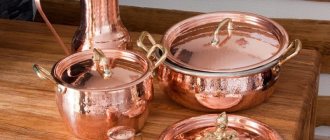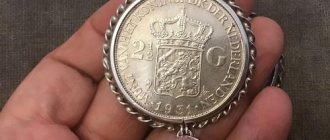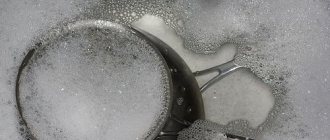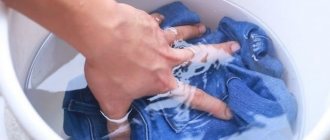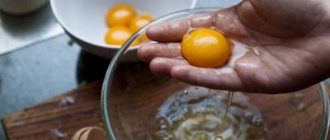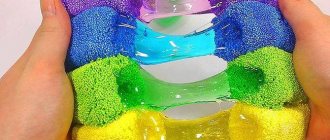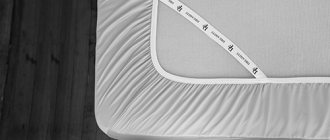Over time, cutlery loses its original shine, sometimes becoming covered with blackness and plaque. You can clean spoons and forks yourself using products found in every home. The method is chosen depending on the material of the cutlery. Spoons and forks plated with gold require more delicate handling than items made of stainless steel or cupronickel.
How to clean spoons and forks with home remedies
If you wish, you can clean spoons and forks using home remedies without resorting to purchasing expensive products. How often the procedure should be carried out depends on the appearance of the devices. If they are covered with plaque, dark spots, or simply lost their shine, it’s time to get down to business.
Boiling
Boiling in ordinary water is more of an auxiliary cleaning method. By boiling, you can soften old plaque on spoons and forks made of stainless steel and other metal. Softened dirt stuck between the elements of the relief surface can then be easily removed with a soft cloth or sponge.
To remove dirt between the teeth, you can use an old toothbrush with dish soap on the bristles.
It is not necessary to boil the appliances on the stove; you can simply pour boiling water over them and place them in a saucepan. This method is used when the forks and spoons are not too dirty. If boiling, keep the appliances on the stove for no longer than 30 minutes. Then they are rinsed in clean water.
Soda, citric acid
You can clean forks and spoons at home with soda and citric acid. First, both products are dissolved in hot water. In order to prepare 2 liters of solution, you will need 2 teaspoons of soda and 1 teaspoon of citric acid.
To clean the devices from dirt, soak them in the prepared mixture for 15 minutes. If there is a large accumulation of dirt, the product can be left longer. To prevent the solution from cooling, place the pan on low heat.
The same tool will help rid appliances of blackness. Boil the blackened forks and spoons in the solution for 5 minutes. After rinsing the products, they must be immediately wiped dry, otherwise a whitish coating may remain.
Toothpaste, powder
When cleaning dishes for serving, choose one product - toothpaste or powder. In this case, the cleaning composition should not contain large abrasive particles and bleaching components.
The devices should be cleaned in the following order:
- Hot water is poured into a deep bowl.
- Soak contaminated utensils for 5 minutes.
- Taking forks and spoons out of the water one by one, remove plaque from them using powder or toothpaste.
- Clean dishes are rinsed in water.
To reduce the consumption of powder, you can prepare a liquid paste from it by mixing it with a small amount of hot water. It is not possible to quickly clean the devices in this way, since they are processed individually.
Foil, soda, salt, boiling water
Foil is usually used to clean silver and stainless steel utensils. This method allows you to bring the dishes to a shine. The method with foil involves placing it on the bottom of the pan, after which teaspoons and tablespoons, forks, and knives are placed there.
Then dissolve 1 teaspoon of salt and soda in a liter of water. The solution should completely cover the devices. Place the pan on the stove and boil for 15 minutes. After this, you can rinse the serving dishes in clean water and wipe dry.
Mustard, soda
You can bring the devices to such a state that they shine by soaking them in a solution of mustard powder and soda. 1 tbsp. A spoonful of both components is dissolved in 1 liter of very hot water. Then the serving dishes are placed in the solution for 30 minutes.
We recommend: Sterilizing jars in the microwave: how to prepare containers for sealing in 5 minutes?
If it is not possible to get rid of old fat particles, the soaking time is extended. Cleaned spoons and forks are washed in clean water; if dirt remains in some places, you can rub these places with a sponge and dishwashing detergent.
Lemon juice
Lemon juice is used when you need to remove blackness from gold-plated or silver-plated forks and spoons. Natural citric acid acts gently without damaging the coating.
To begin, cut the citrus fruit in half and squeeze the juice into a cup. To clean the devices, use a rag or other soft cloth. The cloth is soaked in lemon juice and then wiped over the darkened serving utensils. If the blackness doesn't budge, you can use an old soft-bristle toothbrush. This method can usually whiten even neglected appliances.
Vinegar
Vinegar dissolves grease well and removes dark spots. With this product, you can rub your appliances to a shine using a piece of soft cloth. Hands must be protected with rubber gloves to prevent skin damage.
Fat particles stuck between decorative elements are removed by soaking the devices in a vinegar solution (125 ml of vinegar per 1 liter of water). The forks and spoons filled with the mixture are placed on the fire and brought to a boil, after which the pan is removed from the heat and covered with a lid. When the vinegar solution has cooled, rinse the devices in clean water and wipe with a towel.
Ammonia or ethyl alcohol
You need to use one or the other. Ammonia is a rather aggressive liquid; devices should not be soaked in it, but rather wiped with ammonia using a rag.
A more gentle treatment would be with a solution of ethyl alcohol (add 100 ml of alcohol per 1 liter of water). The serving dishes are soaked in the solution for several hours, then rinsed with clean water and wiped dry. Pure alcohol is used to get rid of individual stains. Apply the product to a cotton pad and then wipe the problem area.
Chalk and ammonia
First you will need to prepare a mixture of crushed chalk and ammonia. The consistency of the composition should resemble liquid sour cream. The method is suitable for cleaning darkened cupronickel devices.
Gold and silver plated items may be damaged by this cleaning method. Cupronickel silver spoons and forks are wiped with a rag soaked in the solution, then they must be washed in water. Clean appliances are removed from residual moisture by wiping with a napkin or towel.
Eggshells and salt
Eggshells and salt will help rid serving utensils of old plaque. Since this composition has abrasive properties, it is used only for cupronickel and stainless steel.
The crushed eggshells are thrown into a pan of boiling water, then 1 tbsp is added here. l. spoon of salt and put cutlery. The boiling process should continue for 5 minutes. After this, the forks and spoons are removed, rinsed and wiped dry.
Garlic peel
A product based on garlic peels is good at removing dark stains and old plaque from dishes. You will first need to make an infusion. The raw materials are collected in advance, then placed in a glass jar and filled with water. After 12 hours, the infusion is brought to a boil and cutlery is immersed in it. Let the forks and spoons sit in the mixture for at least an hour, after which they are washed and dried with a towel.
Turpentine
The product is suitable for cleaning gold-plated dishes. You will have to act slowly, wiping each device with a cotton pad soaked in turpentine. After processing, the product must be washed in clean water. You should not leave spoons and forks damp after the procedure; they should be wiped with a cloth or towel.
Choosing a method taking into account contamination
To properly clean stainless steel cutlery, you need to focus on the nature of the stains that cover them. Below we will discuss how to wash off contaminants of various origins.
Yellow plaque
Tap water contains many impurities, including active substances, with prolonged interaction with which stainless steel gradually becomes yellow. Let's look at ways to help clean it of plaque:
- First you need to wash and peel a medium-sized potato. Then grate it on a coarse grater, and using a sponge, clean the cutlery set. After this, rinse and wipe clean forks and spoons with a soft cloth.
- Instant coffee will help you clean old yellowed utensils until they shine. It should be used as a scrub - pour a little granules into your palm and walk over the moistened stainless steel.
Old fat
If you need to clean your dinner set from old greasy deposits, the life hacks listed below will help:
- First of all, you need to mix in a small container: one hundred milliliters of water, two tablespoons of nine percent table vinegar and five grams of baking soda. Then dip a soft sponge into the active solution and wash the eating utensils from grease.
- A mixture of whitening toothpaste and ammonia (in equal proportions) will help get rid of the old fatty layer. Use this cleaning product to scrub the cutlery until it is completely clean. At the end of the hygiene procedure, rinse and wipe several times.
Tea plaque
You can clean stainless steel spoons and forks from tea or coffee using a regular office eraser. Just keep in mind that it should be soft. The method of application is simple. First, you need to wash the spoons from tea deposits using any dishwashing detergent and wipe them dry. Then use an eraser to clean the darkened areas.
Expert opinion
Evgenia Taran
If you need to clean silver cutlery from tea, you will need to walk over the stained surface with fine table salt. Its particles can effectively remove stains.
Using professional products
When choosing a professional product for cleaning metal products, you need to make sure that it is intended specifically for the metal that is to be cleaned. Liquid products act most delicately. The following gels and sprays are suitable:
- "Sif";
- "Amethyst";
- "Topper"
- "Dr. Beckmann";
- "Sanitol".
We recommend: Who should change meters if they are located on the landing?
Each product has its own instructions; the scheme for their use will be different. Chemical compositions can be safely used for stainless steel and cupronickel. Products made of silver and with applied gilding should be approached individually.
Household chemicals
On store shelves there is a wide range of household chemicals intended for cleaning metal products, including stainless steel. You can find sprays and pastes of domestic or foreign production.
Before using the product, be sure to read the instructions. After cleaning, wipe the cutlery dry with a soft cloth. Household chemicals will quickly and effectively remove various types of dirt, restore shine to products and eliminate minor damage (scratches).
You can clean the devices using chlorine-containing household products (for example, Domestos or bleach). Pour 5 liters of water into a large container and add cleaning agent. Choose household chemicals carefully; it is important that they do not contain acids that negatively affect stainless steel. Place cutlery in the resulting solution and leave for half an hour. After the allotted time, rinse and dry the products.
To clean stainless steel spoons and forks, use special household products or improvised methods. The main thing is not to use strong acids or abrasives, and after cleaning, do not forget to rinse and dry the cutlery.
Features of cutlery made from different materials
Cutlery can be made from various metals and alloys. Sometimes the manufacturer uses additional coating to make forks and spoons more decorative. The properties of the material determine the characteristics of the product.
Stainless steel
Stainless steel cookware and appliances began to be produced after the invention of the 18/10 alloy, which contains 18 parts chromium and 10 parts nickel. Stainless steel immediately created a sensation.
Utensils made from this metal:
- does not oxidize like aluminum;
- does not become rusty;
- has an attractive shine.
Stainless steel has low thermal conductivity, which means the risk of getting burned by hot food when using cutlery is reduced. Stainless steel products can be easily given a variety of shapes, so the design of cutlery can be quite sophisticated.
To further refine the forks and spoons, they can be coated with silver and gold and artistic painting can be applied. Regular stainless steel cutlery does not require complex care and can be washed in the dishwasher. Products with complex shapes and original decor require additional cleaning.
Gold plated
Cutlery made of silver, cupronickel, and stainless steel can be plated with gold. Such products are intended for special occasions; they are not used daily. The thicker the gilding layer and the less often the devices are used, the more durable the decorative coating will be.
You need to take care of gold-plated items with care. They are washed by hand, and then the shine is restored to the devices by polishing them with a suede cloth. The choice of care products for such spoons and forks should be approached carefully. Aggressive compounds are not suitable for gold-plated metal.
Silver
Silver cutlery is prized for its antibacterial properties. In addition, such products look aesthetically pleasing and expensive. A collection of silver spoons can be given as a valuable gift.
Noble metal requires careful handling. Silver cutlery should not be washed in the dishwasher; chlorine-containing products should not be used to clean it. Due to improper care, the metal may become cloudy.
Cupronickel
Cupronickel silver devices are made of a copper-nickel alloy, the ratio of components in which may vary. Cupronickel silver spoons and forks are often coated with gold or silver. There is a misconception that cupronickel devices can be harmful to health, this is not true.
The advantages of products made from this alloy include the fact that they look expensive, do not corrode, and can last from generation to generation. Cupronickel has low thermal conductivity. The disadvantage of metal is that it can darken if there is excess moisture. In general, the material is more demanding to maintain compared to stainless steel.
How to clean cutlery
Why is it important to clean your cutlery regularly?
Untidy appliances can spoil the impression of guests, but it is also unsafe for health.
Stainless steel is quite resistant to rust: the chromium in the composition oxidizes and forms a film. It protects the coating from moisture and stains. But the contaminants that gradually accumulate on forks and spoons (grease, dirt) prevent the formation of this film - as a result, the material quickly wears out. It is important to clean stainless steel items regularly, especially if you use them frequently. This applies to stoves, refrigerator bodies, microwave ovens, sinks, as well as spoons, forks and knives.
Over time, steel tarnishes: a black, white or yellow coating forms on the surface. Bringing your appliances back to shine is another reason for general cleaning.
As a rule, dirt accumulates in hard-to-reach places: in the recesses of threads and patterns, on the inner surface of the teeth of forks. In this case, ordinary washing will not help - radical measures and products with intense effects are required.
Detergents and tools
If you need to wash or clean something, first of all you need to choose suitable household chemicals. The rule is universal and should not be neglected: a product containing an acid will effectively combat contaminants of mineral origin (for example, limescale and rust), but it is useless against organic contaminants (for example, grease, soot and food residues) - alkaline ones effectively deal with them cleaning products.
It is better to give preference to products designed specifically for cleaning stainless steel. A safe composition is no less important: after cleaning the cutlery, no harmful substances should remain on the surface. For regular washing, regular dish gel will suffice. But if used frequently, it is worth cleaning them 1-2 times a week using additional products. They should not contain aggressive bleaching components and abrasive particles that can leave scratches and abrasions on the surface.
The composition of the spray Cif Shiny Effect Anti-grease for the kitchen is ideal for removing organic contaminants from stainless steel. In addition to stoves and sinks, it does an excellent job of removing stubborn dirt on steel forks, knives, and spoons. The product contains citrus essential oils, which provide gentle care for the devices and give them a pleasant aroma. The spray dissolves fat, food debris and dirt and is easily washed off. When using the product, there is no need to polish the cutlery: Cif Anti-grease will help not only quickly clean forks and spoons, but also restore their original shine.
How to clean cutlery without damaging it? Definitely not with steel wool, and in no case with the tip of a knife. It may seem that the point of a knife will help remove dirt in the recesses of the patterns, but the risk of damaging the surface is too high. Use a regular double-sided dishwashing sponge. Another option is an old toothbrush, which can be used to clean hard-to-reach areas.
Cleaning diagram for stainless steel appliances
As already noted, for everyday care, simply washing the utensils with dish gel is enough. You should clean your appliances 1-2 times a week to remove stubborn dirt and restore the shine of the surface. We will need a sponge (or toothbrush), Cif spray.
Treat the surface with a damp sponge. You can add a little detergent or liquid soap.
Apply the spray to the entire surface of spoons, forks and knives.
We clean with a dry sponge or toothbrush, paying special attention to hard-to-reach places.
Rinse in clean water and wipe the devices with a clean, dry cloth.
If there are dried dirt or dark spots on the surface, you should leave the product on the devices for a minute. Be sure to rinse thoroughly with water and polish the appliances with a cloth to add shine.
Regular and thorough care using special stainless steel products will make everyday cleaning of your appliances easier and will maintain their original shine.
Care Tips
Every housewife wants dishes and other items in the kitchen to last longer. A few additional recommendations for caring for steel appliances:
Wash them immediately after eating. Organics and fat are quickly absorbed and it is much easier to remove them immediately.
After washing, dry the appliances with a paper towel or clean cloth. Then they will not be stained by water drops.
Avoid using hard sponges or products with abrasive components that can scratch the steel surface.
To clean the inside of the tines of a fork, take a toothpick, wrap it in cotton wool or a cotton pad, moisten it with stainless steel cleaner and pass it several times between the tines.
Proper storage. Unlike other materials, such as cupronickel and silver, stainless steel is practically undemanding. After washing and drying with a cloth, place the appliances in a dry, clean, designated area for appliances. Let it be a small pull-out kitchen shelf. It is not advisable to store devices in a stand located on the table: grease, condensation and dust settle on them and the devices quickly get dirty.
If you follow these rules, the metal will not darken for long enough. Stainless steel is a durable alloy, resistant to moisture, daily washing and chemicals.
Polished and shiny cutlery will decorate everyday or festive table settings. Your kitchen is perfect!
Tips for caring for cutlery
It is better to wash all cutlery immediately after use, avoiding dirty dishes lying in the sink. In this case, plaque will form on spoons and forks much more slowly. Do not scrub the metal with wire wool or use coarse abrasive substances, otherwise the serving items will become scratched and lose their shine.
Each dishwashing should end with rinsing the appliances, after which they should be wiped dry. It is unacceptable to use concentrated acid for cleaning purposes; it may react with the metal. Forks and spoons containing plastic, stone, or plexiglass in their decoration should not be boiled. They are simply soaked for 30-40 minutes in hot soapy water.
Proper use and regular care will help keep your cutlery in perfect condition for many years. Both folk and professional products can be used to clean products. After the cleaning procedure, forks and spoons are rinsed with clean water and be sure to wipe.
General recommendations for cleaning and storage
To avoid any questions about how to clean spoons and forks, you need to take proper care of them from the moment of purchase. Here are a few tips to help keep your cutlery in perfect condition:
- Washing knives, spoons and forks should be done immediately after eating, before small particles of food have time to dry on them. In addition to the fact that food residues lead to an aesthetic problem, they contribute to the appearance and proliferation of pathogenic microorganisms in the kitchen.
- Plug pins are especially susceptible to contamination. Therefore, when washing dishes, special attention should be paid to these elements.
- If you still can’t wash the dishes quickly, soaking the cutlery in boiling water for half an hour will help clean the cutlery at home.
- It is strictly forbidden to use hard sponges to clean cutlery. Otherwise, microscratches will appear on their surface, which will become an accumulation of dirt.
- To get shiny knives and forks at the end of the hygiene procedure, you should immerse them for a couple of minutes in a bowl of cool water, to which two or three teaspoons of ammonia have been added.
- Upon completion of wet cleaning, you will need to wipe the metal cutlery dry and put it in a special case, or, if it is not available, in a specially designated kitchen drawer.
Features of stainless steel, or what not to do
When trying to clean stainless steel cutlery, it is important to know what can harm the metal.
To avoid damaging stainless steel cookware:
- do not use metal-coated sponges, hard brushes, scourers, or sandpaper;
- Do not clean spoons and forks with sand, tooth powder and other abrasives;
- First dilute baking soda or detergent powder with water until a paste forms;
- Do not store wet cutlery; wipe it dry after washing.
